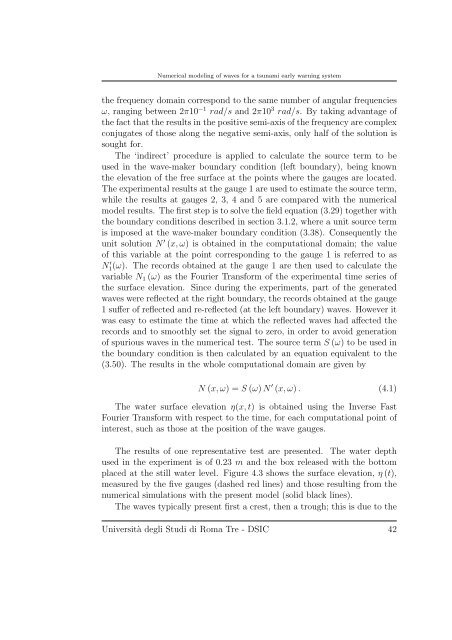Numerical modeling of waves for a tsunami early warning system
Numerical modeling of waves for a tsunami early warning system
Numerical modeling of waves for a tsunami early warning system
You also want an ePaper? Increase the reach of your titles
YUMPU automatically turns print PDFs into web optimized ePapers that Google loves.
<strong>Numerical</strong> <strong>modeling</strong> <strong>of</strong> <strong>waves</strong> <strong>for</strong> a <strong>tsunami</strong> <strong>early</strong> <strong>warning</strong> <strong>system</strong><br />
the frequency domain correspond to the same number <strong>of</strong> angular frequencies<br />
ω, ranging between 2π10 −1 rad/s and 2π10 3 rad/s. By taking advantage <strong>of</strong><br />
the fact that the results in the positive semi-axis <strong>of</strong> the frequency are complex<br />
conjugates <strong>of</strong> those along the negative semi-axis, only half <strong>of</strong> the solution is<br />
sought <strong>for</strong>.<br />
The ‘indirect’ procedure is applied to calculate the source term to be<br />
used in the wave-maker boundary condition (left boundary), being known<br />
the elevation <strong>of</strong> the free surface at the points where the gauges are located.<br />
The experimental results at the gauge 1 are used to estimate the source term,<br />
while the results at gauges 2, 3, 4 and 5 are compared with the numerical<br />
model results. The first step is to solve the field equation (3.29) together with<br />
the boundary conditions described in section 3.1.2, where a unit source term<br />
is imposed at the wave-maker boundary condition (3.38). Consequently the<br />
unit solution N ′ (x, ω) is obtained in the computational domain; the value<br />
<strong>of</strong> this variable at the point corresponding to the gauge 1 is referred to as<br />
N ′ 1(ω). The records obtained at the gauge 1 are then used to calculate the<br />
variable N1 (ω) as the Fourier Trans<strong>for</strong>m <strong>of</strong> the experimental time series <strong>of</strong><br />
the surface elevation. Since during the experiments, part <strong>of</strong> the generated<br />
<strong>waves</strong> were reflected at the right boundary, the records obtained at the gauge<br />
1 suffer <strong>of</strong> reflected and re-reflected (at the left boundary) <strong>waves</strong>. However it<br />
was easy to estimate the time at which the reflected <strong>waves</strong> had affected the<br />
records and to smoothly set the signal to zero, in order to avoid generation<br />
<strong>of</strong> spurious <strong>waves</strong> in the numerical test. The source term S (ω) tobeusedin<br />
the boundary condition is then calculated by an equation equivalent to the<br />
(3.50). The results in the whole computational domain are given by<br />
N (x, ω) =S (ω) N ′ (x, ω) . (4.1)<br />
The water surface elevation η(x, t) is obtained using the Inverse Fast<br />
Fourier Trans<strong>for</strong>m with respect to the time, <strong>for</strong> each computational point <strong>of</strong><br />
interest, such as those at the position <strong>of</strong> the wave gauges.<br />
The results <strong>of</strong> one representative test are presented. The water depth<br />
used in the experiment is <strong>of</strong> 0.23 m and the box released with the bottom<br />
placed at the still water level. Figure 4.3 shows the surface elevation, η (t),<br />
measured by the five gauges (dashed red lines) and those resulting from the<br />
numerical simulations with the present model (solid black lines).<br />
The <strong>waves</strong> typically present first a crest, then a trough; this is due to the<br />
Università degli Studi di Roma Tre - DSIC 42

















